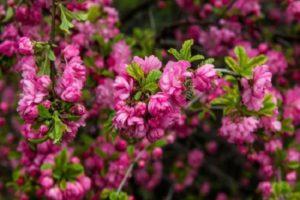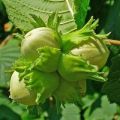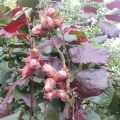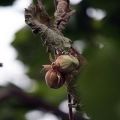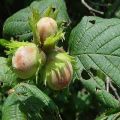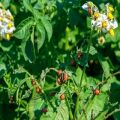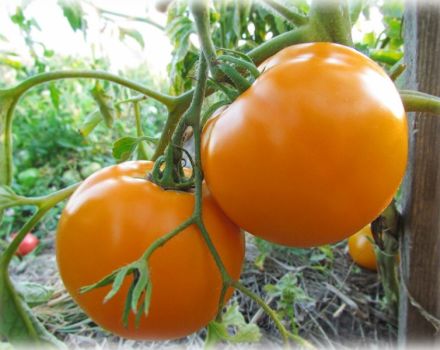Causes and signs of diseases and pests of hazelnuts, what to do to combat them
Growing any horticultural crop does not go smoothly. Pathogenic fungi, harmful insects affect the planting of fruit trees as a result of inept care, weather and climatic anomalies. The specificity of hazelnut diseases is such that it is necessary to fight them, based on the symptoms of pathology. Some of the diseases are characteristic only of the nut crop, so few people from summer residents know about them.
What causes
The causes of hazelnut ailments include:
- improper care of the plant;
- there are no growing conditions for the culture;
- the soils are swampy, saline;
- little light.
During periods of humid and hot summer, the activity of pathogenic fungi increases, hence the high threshold for the incidence of hazel trees. Carelessness of the gardener allows not to notice white spots on the leaves or yellow, brown ones. And this is the first sign of a fungal infection. It is easier to fight against a disease detected in a timely manner. Neglected pathological conditions lead to the death of the walnut plantation.
Diseases and pests of hazelnuts
It is characteristic that the causative agent of the main hazelnut diseases causes infections in other fruit crops. Hazel plantings often suffer from powdery mildew. Aphids can also settle on the leaves of the tree. But there are specific diseases that are found only in the plantings of the nut crop.

Diseases
Hazel suffers from many infections caused by fungi. Viral diseases are rare in the plant.
Powdery mildew
According to research by scientists, this disease occurs on the crop more often than various types of spotting. The yellow aphid provokes the development of the disease. Leaving its excrement on the surface of the leaves, it attracts pathogenic fungi to the plant. With further development, powdery mildew grows into whitish spots containing mycelium spores.
They are visible with the naked eye on the surface of the leaves. The main factors provoking the disease are high air humidity, temperatures above 28 degrees Celsius.
Conidia, overwintering in hazel buds, infect plants. Although many varieties of hazelnuts are resistant to fungus, regular spraying is needed to stop the spread of the pathological process.

Phylostictosis
The disease caused by the fungus is called yellow-brown leaf spot for a reason. Plant tissue necrosis is manifested by large irregular spots.A border is visible along the edges, and dark dots are formed inside. Over time, the affected part of the leaf cracks, falling out. In neglected conditions, the leaves begin to turn yellow and fall off.
The consequence of infection with phyllostictosis will be the weakening of the shoots, their poor maturation. A sick hazel may not survive the winter. To prevent the infection from spreading to neighboring trees, it is necessary to collect and burn the fallen leaves.
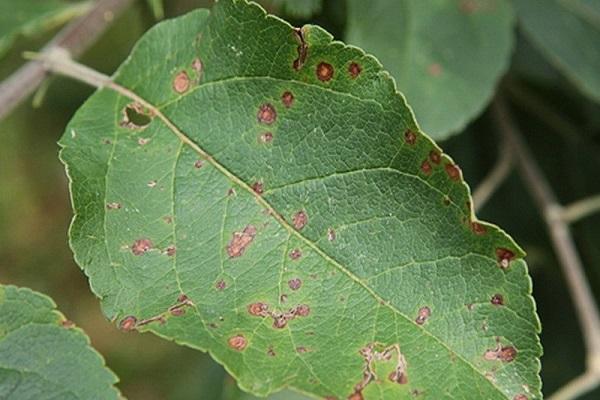
Ocher-brown spot
The leaves on the hazelnut are covered with brown spots. Then they become white, and black dots, the so-called flattened pycnidia, are scattered on top. The consequence of fungal pathology will be drying, foliage falling. But the fungi retain their activity in the fallen leaves affected by the infection.
The development of the disease is favored by warm rainy weather. Pycnids swell, releasing pycnospores. Winding mucous masses are carried by the wind to neighboring plants. Insects help fungi to multiply.
Reddish brown spot
The spots on the leaves are reddish at first, gradually turning into yellow pillows. They contain spores of a pathogenic microorganism. The result of the action of the fungus is a delay in the growth and development of hazelnut shoots. The shrub weakens and bears little fruit.
The disease is more often manifested in the southern zones of hazelnut cultivation. In the gardens of Siberia, the Chernozem region, the fungus rarely spreads, although it can be registered on hazel trees.

Cylindrosporoid spot
Cylindrosporium fungi cause numerous spots on the leaf surface. They are either round or with corners. Spores are collected on the upper side of the leaf with brown pads. In hot, humid weather, the pads burst, allowing the spores to spread to other crops.
Cercosporous spot
The disease is different:
- a lot of spots;
- red-brown dots;
- merging of spots into one grayish area;
- an inconspicuous bloom of mycelium with spores along the edges.
If there are brown dots with a diameter of 1-3 millimeters, then the spot into which they combine can capture the entire surface of the plate.
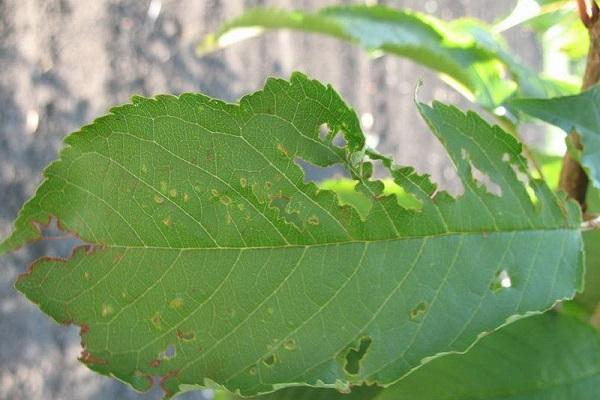
Black spot
Another name for the disease is phomopsis. It is dangerous because it affects all parts of the plant. Pathology is determined by:
- discoloration of lignified shoots;
- dark spots on the bark;
- the withering away of branches;
- brownish spots with a lightened middle on the leaves.
Plaque on the surface of the leaf plate indicates the spread of the disease by spores. From a diseased tree, neighboring ones become infected, since spores are carried by precipitation, wind, insects. The nut stops developing, blooming, bearing fruit.
Pests
There are also many insects that infect hazelnuts and hazelnuts. Some of the pests parasitize, feeding on the juices of the leaves, while others feast on the delicious fruits of the tree, their pulp.
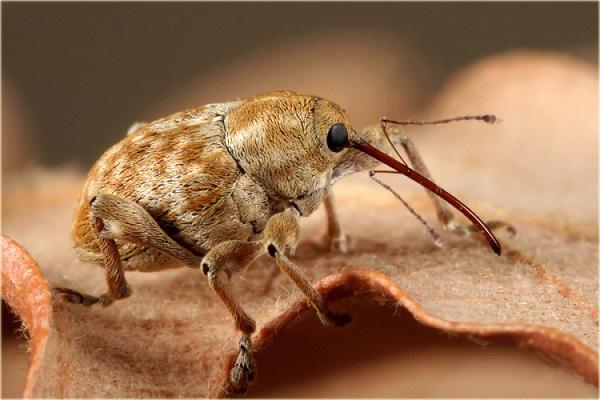
Birch cushion
The pest belongs to small-sucking insects. It has a convex body up to 8 millimeters long and 3-4 mm wide. Adult insects are immobile, but their offspring, larvae, cause great harm to the hazel. They feed on the juice of hazelnut bark. Hibernating under it, in the spring they continue to harm the nut. In females, a mealy egg sac up to 1 centimeter in size is formed, which looks like a pillow. In the middle of summer, the female lays up to 600 eggs in it. They are less than 1 millimeter in size, red.
The pest is most often found in the European part of Russia, in southern Siberia, in the Far East.
Green garden bug
Every summer resident met with a garden bug. It is a very mobile insect with a green shiny body and leathery front wings. The bug belongs to the sucking pests. The larvae are outwardly similar to adults, but are light brown in color. They affect all parts of the garden and vegetable garden. Due to the action of adult insects and larvae, hazelnut leaves acquire a wrinkled shape, turn yellow, and the inflorescences fall off.
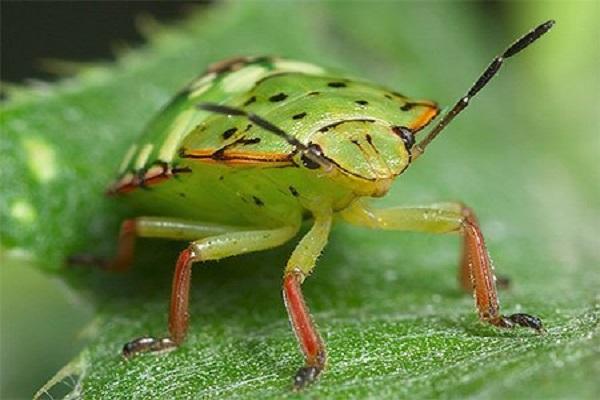
Hazel weevil
You can recognize the pest by its long proboscis. The black bug has a body 6-8 millimeters long, and a nose - 4. Yellow-gray scales give the insect a light shade. For wintering, weevil larvae burrow into the ground, where they pupate. In spring, beetles find their food on hazel. And the female lays eggs in the pulp of the nuts that are tied. There parasites live, eating the insides of hazelnut fruits. The larvae live for 25 days.
Resistant varieties of hazelnuts to the weevil have not been bred, therefore, the pest has to be fought everywhere.
Hazel pipe runner
The beetle is 6-7 millimeters long and is distinguished by its black body and red back. The structure of the insect's head is interesting: it is elongated by a tube with an extension at the top, as if pulled from the sides. White thick larvae of the tube-worm are inactive and feed on the green parts of the plant. The eggs are laid by the female in a rolled hazel leaf. The leaves begin to dry and fall off.

Walnut barbel
One of the dangerous pests that can destroy walnut plantations begins its activity in early May. Making a flight around its possessions, an insect with long black antennae lays eggs under the bark of hazelnuts. Already in June, the larvae that appear begin to gnaw the branches of the bush. The shoots dry up, and the foliage turns yellow and falls off. You can identify the pest by twisting the foliage in the upper parts of the shrub. Although the root remains alive, the plant is not able to revive again.
After wintering, the larvae infect 2-3-year-old shoots. Gnawing passages in the branches, they lead to the drying out of most of the shoot.
Alder leaf beetle
This bug is dangerous for industrial hazelnut plantations. It can be identified by black legs and antennae, elytra of purple tint. In April, beetles appear on hazelnuts when they wake up after wintering. The parasite attacks the leaves of the hazel, which it eats with lightning speed. The larvae are born from the eggs laid on the plant. The duration of their life span is 25 days.
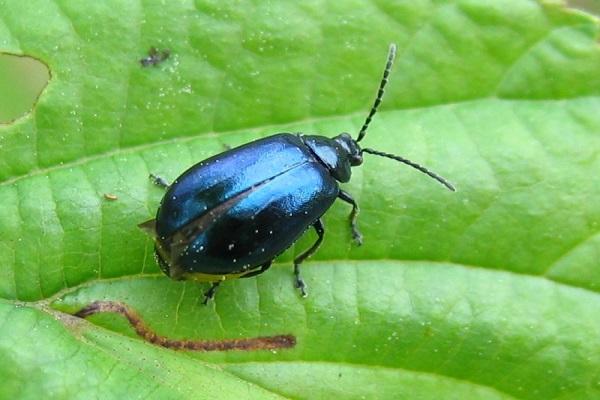
Northern birch sawfly
Hymenoptera larvae hatch from eggs laid on the underside of the leaf. Dirty green caterpillars are so gluttonous that they can completely devour all hazelnut. Moreover, they appear twice over the summer: in May and from July to September.
An adult insect with a black shiny body and transparent wings feeds mainly on birch leaves. You can see sawflies in early summer when they fly around the garden. Females cut the underside of the leaf and lay 1 egg in each. Caterpillars pupate in the ground where they hibernate.
Moth-speckled hazel
If a small butterfly with narrow silvery wings flies around the tree, then this is a speckled moth. Its larvae harm the leaves of the hazel, biting into the thickness of the leaf. Eating out a significant mine visible from the lower part of the leaf, the larva moves to the upper part. In this case, the leaves become marble-spotted in color. Larvae live in mines, turn into pupae, being in this stage for only 8-9 days. In July-August, a butterfly flies out of a fragile cocoon.

Moth-crumb hazel serpentine
A butterfly with beautiful fringed hind wings is not dangerous itself. But its larvae, appearing on the leaves of the hazelnut, make passages inside the plant tissues, similar to the trail of a snake. This pattern, decorated with parasite excrement, can be used to identify the pest. After 3 weeks, the caterpillar gets out of the leaf, falling to the ground. It pupates and overwinters safely in the ground until spring.
Hazel pocket moth
They are distinguished by a small, slightly more than 1 centimeter, a butterfly, silvery wings and a fringe behind them. The larvae hide in curved leaves like pockets, feeding on their juices. They hold the parts of the shelter together with a sticky spider web. Inside the sheet, tissues are eaten away, which are skeletonized.During the period of its development, the caterpillar makes up to 4-5 pockets. In dry and hot summers, moths cause significant damage to hazel trees.
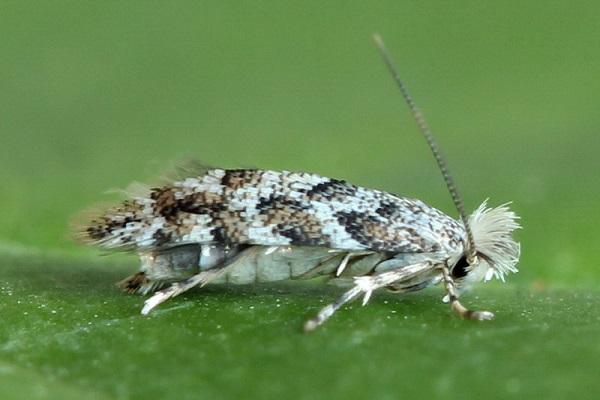
Insect and disease control methods
Pest control of the walnut plantation should take time to save the crop:
- As soon as the opening of hazel leaves begins, spraying with the preparations "Fufanon" or "Kemifos" is carried out.
- Suitable for the destruction of pests "Karbofos", "Fozalon".
- Processing is carried out twice more of those trees on which pests are found.
- The folded leaves are collected by hand.
- Weevils, bugs are shaken off on the ground, having previously laid a sheet of cellophane or non-woven material. Then they are destroyed.
- Burning plant residues in autumn, as well as digging up the soil, is imperative in order to destroy pupae and larvae of parasites.
- After the snow melts, dried branches are cut off 10-15 centimeters below the drying level.
- Pruning is continued in July-August, capturing 2-3 healthy leaves.
- In the spring, before the insects emerge, it is necessary to cultivate the soil with 10% "Bazudin", embedding the granules in the ground.
The method of combating hazelnut diseases is the same: treating the affected plants with fungicides. In the spring, as the kidneys swell, they are sprayed with Bordeaux liquid with a concentration of 1%. Walnut bushes damaged by fungi can be treated with Abiga-Peak three times.

Copper preparations are used to fight many fungal infections. From folk remedies, the use of herbal infusion is effective. To prepare it, take dry grass, pour it with warm water in a 1: 1 ratio. It is necessary to keep the solution for a week, then filter it and spray it with nut bushes. Better to carry out the treatment in the evening.
If the hazelnut fruit drops, then it is necessary to collect and destroy them. They are damaged by pests that can kill all trees. From the methods of combating diseases, loosening of the soil in the aisles in spring and autumn can be distinguished. Digging the site will save you from diseases and pests.

Prevention measures
Preventing diseases is easier than finding a way to get rid of them later. Prevention measures include:
- timely watering and feeding of hazel, hazelnuts;
- removal of damaged shoots;
- pruning branches thickening the crown of hazel;
- regular inspection of plants;
- protecting them from frost, heat, high humidity;
- digging the soil in spring and autumn.
The nut plantation can only be saved by competent agrotechnical measures. To ensure health of hazelnut plantings, you should not plant birch or alder nearby. The pests of these trees can move to the hazel and destroy it. If the infection has occurred, then it is necessary to get rid of the plant where the pests have settled, as from the source of the disease. Or the hazel can be found in another place on the site.

